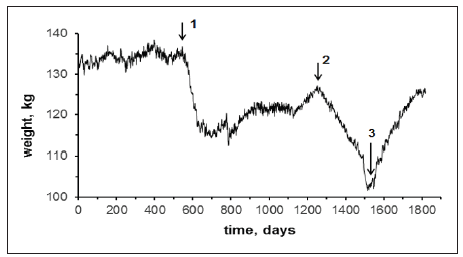- Submissions

Full Text
Novel Approaches in Cancer Study
Change of Individual Weight of a Patient with Autoimmune Thyroiditis and Colon Cancer Before and After Treatment
Zotin AA*
NK Koltsov Institute of Developmental Biology, Russia
*Corresponding author:Zotin AA, NK Koltsov Institute of Developmental Biology, Moscow, Russia
Submission: September 19, 2019;Published: October 24, 2019

ISSN:2637-773XVolume3 Issue4
Abstract
Human growth, as a rule, is studied in the youthful period, limited to the first 20-30 years of life. This is largely due to the fact that a person’s linear growth in height ends by 18-22 years old Bogin [1]. A person’s weight reaches a maximum by 25-30 years Zotin [2]. However, a change in body mass occurs throughout life. In addition, growth is usually accompanied by biorhythms even during periods when changes in average body weight are not observed. The initial goal of the work was to identify growth biorhythms in adults measuring my weight for example. However, during the study, diseases that affect body weight were discovered. Accordingly, the purpose of the work has changed.
Materials and Methods
I took measurements of my own weight on a floor scale with an accuracy of 100g, starting from the age of 21,748 days (≈59.6 years) daily. The start date of measurements (26 September 2014) is taken as 0. The last date was 18 September 2019 (1842 days after the start of measurement; ≈5.0 years). Autoimmune thyroiditis was diagnosed on day 557 (05 April 2016). Treatment with sodium levothyroxine (Eutiroks, Merck KGaA, Darmstadt, Germany) was prescribed. Drug regimen was daily intake of 100mg. Treatment started from 569 day. The dose was increased to 150mg starting from 1251 day. Monitoring of the course of treatment was carried out by analyzing the blood levels of free triiodothyronine, free thyroxine, thyroid-stimulating hormone, antibodies to thyroglobulin, antibodies to thyroid pyroxidase.
On day 1498 an operation (laparotomy) was performed according to the results of which cancer of the rectosigmoid colon was diagnosed. From 1540 days a course of chemotherapy was started according to the following scheme. Intravenous administration of bevacizumabi (“BIOCAD”, Russia) at a dose of 800mg, oxaliplatini (“EBEWE Pharma”, Russia) at a dose of 100mg, ondansetron (“Sotex Pharmfirm”, Russia) at a dose of 16mg on the first day. Oral administration of capecitabini (“Pharmasyntez-Nord”, Russia) fFrom the day 2 to the day 15. Medicines are not accepted from the day 16 to the day 21. This pattern is repeated continuously. Monitoring of the course of treatment was carried out using computed tomography. Biorhythms were detected by singular spectrum analysis using Caterpillar-SSA software (version 3.40, by Gista T Group, Russia).
Results
The study of changes in body weight can be divided into three periods.
1) Without treatment (0-568 days).
2) Treatment for autoimmune thyroiditis (569-1539 days).
3) Treatment for autoimmune thyroiditis and chemotherapy (1540-1818 days) (Figure 1).During the first stage body weight tends to remain constant. The figure shows distinct growth biorhythms in this stage. A singular spectral analysis shows that five regular biorhythms can be distinguished, the period and amplitude of which remain constant.
a) Biorhythm with a period of ≈0.5 years (period P = 198±24 days; amplitude A = 0.99 ± 0.15kg).
b) Biorhythm with a period of about a month (P=31.1±2.1 days; A=0.30±0.04kg).
c) Biorhythm with a period of ≈3 weeks (P =21.3±1.2 days; A = 0.13±0.01kg).
d) Biorhythm with a period of ≈2 weeks (P = 14.3±0.2 days; A = 0.17±0.01kg).
e) Biorhythm with a period of about a week (P = 7.1±0.1 days; A = 0.24±0.01kg).
Whether these biorhythms are endogenous or exogenous remains unclear. The change in body weight in the second and third stages is shown in the (Figure 1). Despite changes in body weight, all five biorhythms persist at these stages. However, the amplitude of these biorhythms varies. The pattern of the amplitude changes is not clear. Of course, data based on a single case is not enough for any conclusions about the patterns of human growth in normal and pathological conditions. However, the proposed data may provide the basis for further research.
Figure 1:Body weight dependence on the period from the start of the measurement. Arrows: 1 - start of treatment with sodium levothyroxine at a dose of 100mg/day; 2 - dose of sodium levothyroxine changed by 150mg/day; 3 - the beginning of chemotherapy.

Acknowledgment
The author is grateful to the doctors of Dorzhiev S.D. (endocrinologist) and Dr. Polyansky M.A. (oncologist) for the appointment and treatment. The study was conducted as part of the state program of basic scientific research of the Koltzov Institute of Developmental Biology, Russian Academy of Sciences, no. 0108- 2019-0003.
References
- Bogin B (2015) Human growth and development. In: Michael P Meuhlenbein (Ed.), Basics in Human Evolution, London: Academic Press, USA, pp. 285-293.
- Zotin AA (2006) Equations describing changes in weight and mass-specific rate of oxygen consumption in animals during postembryonic development. Biology Bulletin 33(4): 323-331.
© 2019 Zotin AA. This is an open access article distributed under the terms of the Creative Commons Attribution License , which permits unrestricted use, distribution, and build upon your work non-commercially.
 a Creative Commons Attribution 4.0 International License. Based on a work at www.crimsonpublishers.com.
Best viewed in
a Creative Commons Attribution 4.0 International License. Based on a work at www.crimsonpublishers.com.
Best viewed in 







.jpg)






























 Editorial Board Registrations
Editorial Board Registrations Submit your Article
Submit your Article Refer a Friend
Refer a Friend Advertise With Us
Advertise With Us
.jpg)






.jpg)














.bmp)
.jpg)
.png)
.jpg)










.jpg)






.png)

.png)



.png)






